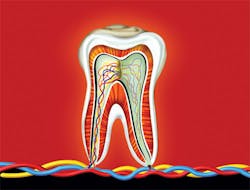Ask the Experts: Desensitizers
Sensitivity can make life difficult for patients—and it can make treating them difficult for you. In this installment of our new feature series, our editorial advisory board shares their thoughts and recommendations on how to treat sensitivity in two different patient scenarios.
© Mkkans | Dreamstime.com
Patient A
This 52-year-old male patient has been treated for periodontitis for approximately five years. The treatment has prevented further recession, but he experiences generalized sensitivity due to this condition. He is sensitive to scaling (especially near the gumline) and use of the Cavitron.
Patient B
This 36-year-old female patient has two sensitive teeth that are aggravated by acid exposure. The sensitive teeth are not carious. She is unable to put ice in her drinks and often drinks water infused with lemon. She has tried potassium nitrate toothpaste at home, but it has not helped.
Staci Violante, MSDH, RDH
Both surgical and nonsurgical periodontal therapies have been shown to increase the prevalence of hypersensitivity related to gingival recession, root exposure, or both. For patients with recession, such as Patient A, I recommend either MI Paste or MI Paste Plus (GC America) via a prophy cup or tray application.
The water-based sugar-free paste replenishes minerals in the teeth and strengthens them. There are many benefits to MI Paste that make it my first choice, including that it alleviates dry mouth caused by medications; reduces high oral acid levels from excessive soft-drink consumption; alleviates tooth sensitivity before or after a professional cleaning; prevents white spot lesions that may occur from orthodontic treatment; and provides a topical coating to ease suffering from acid erosion and caries. It is used in the office and is available for the patient to use as part of their home-care regimen.
If erosion is the cause of dentinal hypersensitivity on a patient, such as it is with Patient B, my initial plan includes taking and/or reviewing the patient’s medical history, as well as screening to identify any predisposing contributors. In this case, drinking water infused with any acidic fruit will cause erosion over time. My desensitizing agent of choice is Colgate Sensitive Pro-Relief desensitizing paste for patients sustaining dentinal hypersensitivity. The components seal the exposed dentinal tubules to provide fast relief shortly after application. Applying this product before scaling reduces the patient’s discomfort tremendously, especially with the ultrasonic scaler. Reapplying the Colgate paste when treatment is completed provides further relief lasting up to four weeks. I recommend take-home products and follow-up visits to monitor treatment and to reduce, if not eliminate, pain.
Amber Auger, MPH, RDH
The desensitizer I would choose to use on Patient A is GingiCaine oral anesthetic gel with 20% benzocaine (Gingi-Pak). This product is great because onset is quick, and it lacks a gritty feeling or poor taste! I find that when I use this, I provide comfort to patients when scaling. The fast onset is great because I can begin scaling the patient almost immediately.
In Patient B’s case, I would use GingiCaine while cleaning the teeth, and then I would use Pain-Free gel dentin desensitizer (Parkell). I like this product because the gel does not run, onset is quick, and application is easy. Additionally, the product offers a unique formula of three polymers for more effective results. The formula seals the open tubules of the tooth and grafts the molecules tightly to calcium in the hydroxyapatite. The consistency of the product is much thicker; therefore, it is best for this patient because the gel will not slide off the “glassy” surface of the enamel that has been affected by acid. In addition, no curing light is needed for application.
Any special considerations for application?
Traumatized mucosal areas that are infected should be avoided. Excess saliva should be removed to prevent the local anesthetic from being diluted. Gently apply the GingiCaine, being careful to avoid causing trauma to the tissue. Allow the gel to remain in place for 60 seconds and then suction additional gel out.
Apply the Pain-Free gel to the sensitive root surface or surfaces for 20 to 40 seconds with a cotton or microbrush applicator. Dry angles and cotton rolls may be used to prevent saliva from compromising the gel. For patients with excess saliva, a rubber dam may be considered.
Are there contraindications or special considerations for these patients?
Patients who are allergic to ester-type anesthetic, such as procaine, benzocaine, tetracaine, or Red 40 dye, should not be treated with GingiCaine.
Application of Pain-Free gel will reduce the bond strength of dental resin composite restorations that are placed on it. Patients who are sensitive to acrylates, methacrylates, or similar materials should avoid using the product.
Kristin Goodfellow, RDH
For Patient A, I would recommend Flor-Opal sustained-release fluoride gel (Ultradent Products Inc.). This patient has reached a relatively controlled state of his disease. I would want to create custom fluoride trays for this patient. In the trays, my preference is to use the Flor-Opal gel. It is sticky and provides benefits even once the tray is removed, because the gel isn’t easily rinsed away.
For Patient B, my first recommendation is to continue using toothpaste products with potassium nitrate, as they will help seal the dentinal tubules leading to the nerve. As an added layer of protection that will hopefully provide some comfort as well, I would recommend this patient use Clinpro 5000 (3M).
Clinpro 5000 toothpaste releases a high level of fluoride plus calcium and phosphate—components found naturally in saliva. Clinpro 5000 delivers more fluoride and calcium to the tooth structure and has low abrasion, making it comfortable for use with many patients.
Any special considerations for application?
For Patient A, the length and number of times the tray is worn depends on the condition, the patient, and the clinician. Mostly, I recommend that patients wear their tray at night; the gel stays active for about 8 to 10 hours because of slower muscle and salivary activity. This is where they can get the most benefits from the gel.
For Patient B, rather than using the Clinpro 5000 as a traditional toothpaste, I prefer to apply it to the affected area only. I refer to Clinpro as a “tooth lotion,” and have the patient put it on the sensitive area with their finger and leave it there. Allow it to sit on the area for maximum absorption, making this more of a fluoride treatment. As with most other fluoride products, you want to wait to eat or drink anything for at least 60 minutes after applying the product to the area.
Are there contraindications or special considerations for these patients?
Since Patient A is sensitive to scaling, he would likely be sensitive to cold. You can actually warm the gel prior to placing it in the tray by placing it in warm water for several minutes. This can make it a more comfortable and enjoyable experience for the patient.
Beyond prescribing Clinpro 5000 for daily home use, I would recommend that Patient B eliminate the lemon in her water. The continual acid exposure, for hours at a time, could be a significant contributing factor in her battle against sensitivity. If she does not feel any improvement, or would not comply with eliminating the lemon, then I would recommend customized fluoride home trays.
Amber Metro-Sanchez, BA, RDH
For the patient with generalized recession, I would recommend applying Colgate Anywhere, Anytime sensitivity relief serum. For the female patient with a few sensitive teeth, I would try Pain-Free Gel by Parkell.
Colgate Anywhere, Anytime relieves sensitivity rapidly, and it can be easily applied to all teeth surfaces at one setting. Its formulation contains both arginine and calcium carbonate. Pain-Free Gel is a great product when it comes to providing long-lasting sensitivity relief to a few areas. This product can be applied in less than a minute and is effective immediately. This product seals open tubules with a unique formula of three polymers.
Any special considerations for application?
I would apply the Anytime, Anywhere serum with a prophy cup before scaling to improve patient comfort throughout the hygiene procedure. In the second case, I would apply the Pain-Free Gel at the end of the appointment, when the teeth are totally clean.
Are there contraindications or special considerations for these patients?
With sensitivity concerns, sometimes it pays to be persistent and try out several different products to see what works best for each individual patient. As evidenced with Patient B, toothpaste with potassium nitrate does not help everyone, but often another product with a different ingredient will prove effective. Also consider that home habits, such as drinking the water infused with lemon, can be hard to change. Suggesting that the patient drink with a straw may help decrease sensitivity in the future.




